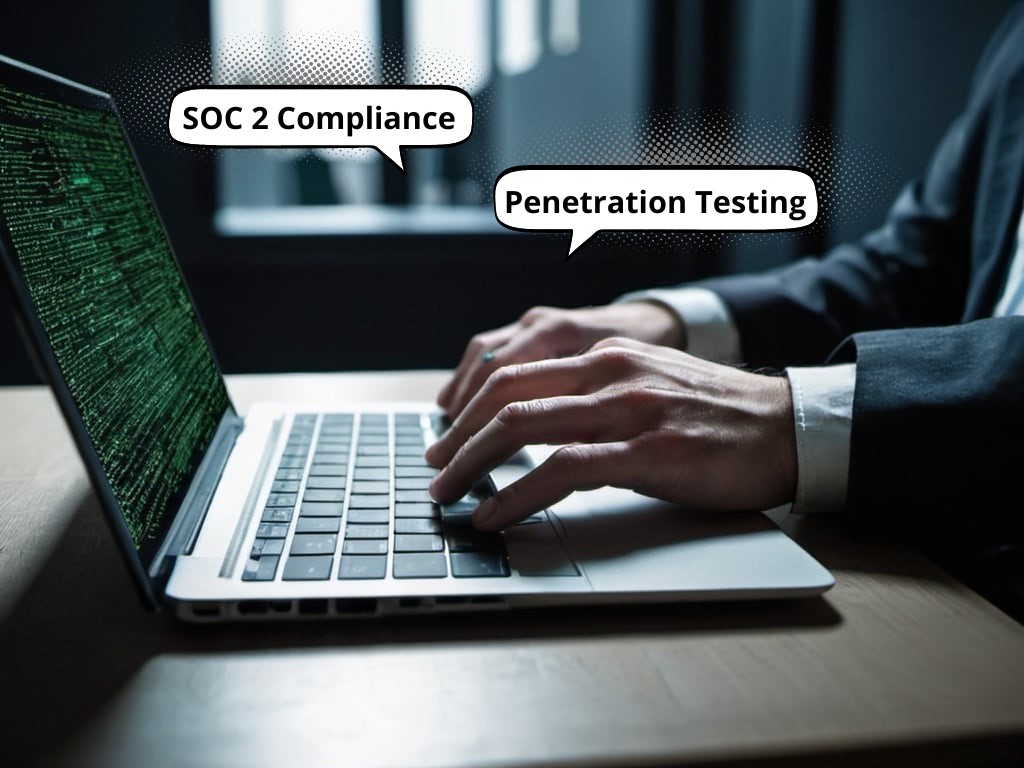Navigating SOC 2 Compliance and Penetration Testing: Comprehensive Guide

In today's digitally-driven landscape, ensuring the security and privacy of sensitive data is paramount for businesses across all sectors. With the rise of cybersecurity threats and regulatory standards, organisations must adopt robust measures to safeguard their systems and uphold trust among their clients and stakeholders. SOC 2 compliance and penetration testing emerge as vital components in this endeavour, serving as pillars for fortifying cybersecurity frameworks. Let's delve into what SOC 2 compliance entails, why penetration testing is crucial, and what organisations need to know to navigate this intricate terrain.
Understanding SOC 2 Compliance:
SOC 2, developed by the American Institute of Certified Public Accountants (AICPA), is a widely recognized framework for assessing and managing the security, availability, processing integrity, confidentiality, and privacy of data stored in the cloud. It ensures that service providers securely manage data to protect the interests and privacy of their clients.
Core Components of SOC 2 Compliance:
- Trust Service Criteria (TSC): SOC 2 compliance revolves around five trust service criteria: Security, Availability, Processing Integrity, Confidentiality, and Privacy. These criteria serve as the foundation for evaluating an organisation's controls and processes,
- Policies and Procedures: Establishing comprehensive policies and procedures is essential for meeting SOC 2 requirements. This includes defining roles and responsibilities, access controls, data encryption protocols, incident response plans, and more,
- Risk Management: Conducting risk assessments to identify potential threats and vulnerabilities is integral to SOC 2 compliance. Implementing risk mitigation strategies and regularly reviewing and updating them are crucial steps in this process,
- Continuous Monitoring: SOC 2 compliance is not a one-time endeavour but an ongoing commitment. Continuous monitoring of systems, processes, and controls is essential to ensure compliance and detect any deviations promptly.
The Significance of Penetration Testing:
While SOC 2 compliance establishes a robust framework for data security and privacy, penetration testing serves as a proactive measure to assess the effectiveness of these controls. Penetration testing, often referred to as ethical hacking, involves simulating cyberattacks to identify vulnerabilities in systems, networks, and applications before malicious actors exploit them.
Key Benefits of Penetration Testing:
- Identifying Weaknesses: Penetration testing helps organisations identify vulnerabilities in their infrastructure, applications, and configurations that could be exploited by cybercriminals.
- Risk Mitigation: By uncovering vulnerabilities proactively, organisations can mitigate potential risks before they result in security breaches or data compromises.
- Compliance Requirements: Many regulatory standards, including SOC 2, mandate regular penetration testing to assess the effectiveness of security controls and ensure compliance.
- Enhanced Security Posture: Regular penetration testing enables organisations to strengthen their security posture by addressing identified vulnerabilities and implementing necessary remediation measures.
Integrating SOC 2 Compliance and Penetration Testing:
Integrating SOC 2 compliance and penetration testing is imperative for organisations seeking to bolster their cybersecurity defences comprehensively. While SOC 2 compliance lays the groundwork for robust security controls, penetration testing offers a proactive approach to identify and address potential weaknesses. By combining these initiatives, organisations can ensure a holistic approach to cybersecurity, safeguarding their data assets and maintaining trust with clients and stakeholders.
Best Practices for Integrating SOC 2 Compliance and Penetration Testing:
- Develop a Comprehensive Security Strategy: Align SOC 2 compliance efforts with penetration testing initiatives within a broader security strategy tailored to the organisation's specific needs and risk profile,
- Regular Testing Cadence: Establish a regular cadence for penetration testing to ensure continuous monitoring and assessment of security controls and processes,
- Collaborative Approach: Foster collaboration between internal teams, external auditors, and penetration testing experts to leverage diverse expertise and insights,
- Documentation and Reporting: Maintain thorough documentation of SOC 2 compliance activities and penetration testing results to demonstrate adherence to regulatory requirements and facilitate continuous improvement.
In conclusion, SOC 2 compliance and penetration testing are indispensable components of a robust cybersecurity framework in today's threat landscape. By understanding the nuances of SOC 2 compliance requirements and the importance of penetration testing, organisations can fortify their defences, mitigate risks, and instil confidence among clients and stakeholders in their commitment to data security and privacy. Embracing a proactive and integrated approach to cybersecurity is paramount in safeguarding sensitive data and preserving organisational integrity in an ever-evolving digital ecosystem.
Curious about how Dhound can assist in meeting SOC 2 compliance requirements?
Dhound's SOC 2 penetration testing swiftly and effectively evaluates your organisation's online assets to pinpoint vulnerabilities necessitating mitigation.
Dhound accomplishes this task by furnishing risk evaluations through both manual penetration testing and automated and vulnerability scanning.
Our Penetration Testing services contribute to:
- Enhancing security across web and mobile applications, cloud infrastructure, networks, and APIs,
- Upholding compliance with regulatory mandates such as SOC 2, PCI DSS, ISO 27001, HIPAA, and GDPR,
- Identification and assistance in eliminating vulnerabilities and security flaws of various levels of criticality.


